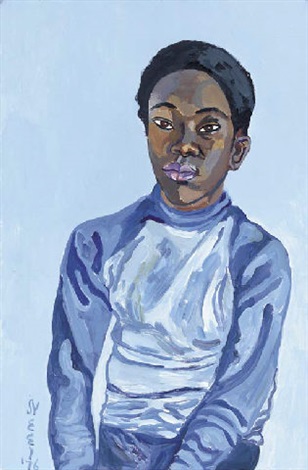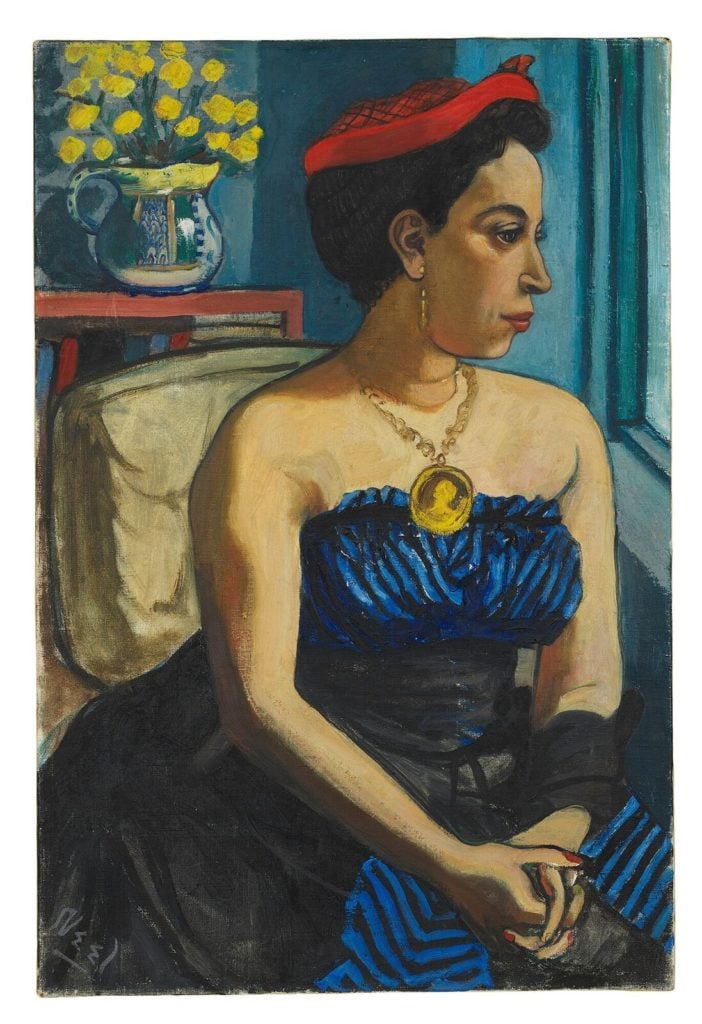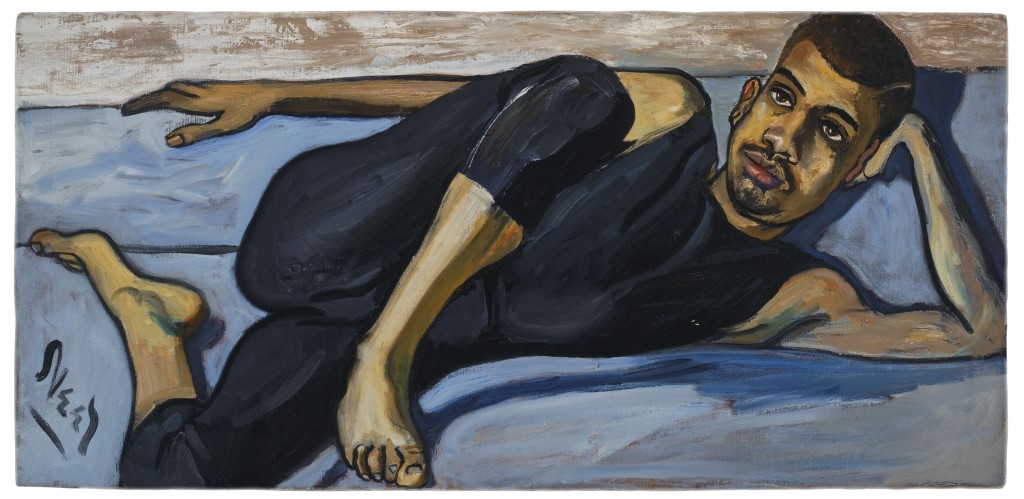David Zwirner, New York
23 February–22 April 2017
Victoria Miro
16 Wharf Road, London N1 7RW
18 May–29 July 2017
18 May–29 July 2017
Curated by the celebrated US critic and author Hilton Als, Alice Neel, Uptown focuses on paintings made by the artist during the five decades in which she lived and worked in upper Manhattan, first in Spanish (East) Harlem, where she moved in 1938, and, later, the Upper West Side, where she lived from 1962 until her death in 1984. An accompanying catalogue, jointly published by David Zwirner Books and Victoria Miro, includes essays by Hilton Als on individual portraits and their sitters, in addition to new scholarship by Jeremy Lewison.
Julie and the Doll, 1943, oil on canvas, 71.4 x 51.4cm, 28 1/8 x 20 1/4 inches
Intimate, casual, direct and personal, Alice Neel’s portraits exist as an unparalleled chronicle of New York personalities – both famous and unknown. A woman with a strong social conscience and equally strong left-wing beliefs, Neel moved from the relative comfort of Greenwich Village to Spanish Harlem in 1938 in pursuit of “the truth”. There she painted friends, neighbours, casual acquaintances and people she encountered on the street among the immigrant community, and just as often cultural figures connected to Harlem or to the civil rights movement.
Ed Sun, 1971, oil on canvas, 106.7 x 76.2 cm, 42 x 30 in
Neel’s later portraits, made after moving to the Upper West Side, reflect a changing milieu, yet remain engaged more or less explicitly with political and social issues, and the particularities of living and working under, as Neel put it, “the pressure of city life”.
Benjamin, 1976, acrylic on board, 29 x 20 inches, 75.9 x 52.7 cm
Highlighting both the innate diversity of Neel’s approach to portraiture and the extraordinary diversity of twentieth century New York City, in this exhibition Hilton Als brings together a selection of Neel’s portraits of African Americans, Latinos, Asians, and other people of colour. As Als writes, “what fascinated her was the breadth of humanity that she encountered”.
Alice Childress, 1950 Collection of Art Berliner
Pregnant Maria, 1964
Ballet Dancer, 1950. Oil on canvas, 51.1 x 107 cm, 20 1/8 x 42 1/8 inches. Hall Collection
In the years since her death, viewers young and old have experienced the kind of thrill I feel, still, whenever I look at Neel’s work, which, like all great art, reveals itself all at once while remaining mysterious. In recent years, I have been particularly intrigued by Neel’s portraits of artists, writers, everyday people, thinkers, and upstarts of colour. When she moved to East Harlem during the 1930s Depression, Neel was one of the few whites living uptown. She was attracted to a world of difference and painted that. Still, her work was not marred by ideological concerns; what fascinated her was the breadth of humanity that she encountered in her studio, on canvas.
But by painting the Latinos, blacks, and Asians, Neel was breaking away from the canon of Western art. She was not, in short, limiting her view to people who looked like herself. Rather, she was opening portraiture up to include those persons who were not generally seen in its history. Alice Neel, Uptown, the first comprehensive look at Neel’s portraits of people of colour, is an attempt to honour not only what Neel saw, but the generosity behind her seeing.” – Hilton Als
Alice Neel was born near Philadelphia, Pennsylvania in 1900 and died in 1984 in New York. Renowned for her portraits of friends, family, acquaintances, fellow artists and critics, Neel was among the most important American artists of her time. In 1974 a retrospective exhibition was held at the Whitney Museum of American Art, New York, an event that was repeated in 2000, marking the centenary of her birth. Recent solo exhibitions have included Alice Neel: The Subject and Me, Talbot Rice Gallery, The University of Edinburgh (2016); Alice Neel: Intimate Relations at Nordiska Akvarellmuseet, Skarhamn (2013); Alice Neel: Painted Truths, a retrospective that toured to the Museum of Fine Arts Houston (2010), the Whitechapel Art Gallery, London (2010) and the Moderna Museet, Malmö (2010-11).
Alice Neel: Painter of Modern Life, a major survey of the artist’s work featuring some seventy paintings was organised by Ateneum Art Museum, Helsinki in 2016. It subsequently travelled to the Gemeentemuseum, The Hague and is on display at the Fondation Vincent Van Gogh in Arles, France (until September 2017), before concluding at the Deichtorhallen Hamburg.
The Estate of Alice Neel has been represented by Victoria Miro since 2004; this is her sixth solo exhibition with the gallery. Her work is in the collections of major museums internationally including the Art Institute of Chicago; the Brooklyn Museum of Art, New York; the Denver Art Museum; the Milwaukee Art Museum; the Moderna Museet, Stockholm; the Museum of Contemporary Art, Los Angeles; the Museum of Fine Arts, Boston; the Museum of Fine Arts, Houston; the Museum of Modern Art, New York; the Philadelphia Museum of Art; Tate, London and the Whitney Museum of American Art, New York.
Alice Neel: Painter of Modern Life, a major survey of the artist’s work featuring some seventy paintings was organised by Ateneum Art Museum, Helsinki in 2016. It subsequently travelled to the Gemeentemuseum, The Hague and is on display at the Fondation Vincent Van Gogh in Arles, France (until September 2017), before concluding at the Deichtorhallen Hamburg.
The Estate of Alice Neel has been represented by Victoria Miro since 2004; this is her sixth solo exhibition with the gallery. Her work is in the collections of major museums internationally including the Art Institute of Chicago; the Brooklyn Museum of Art, New York; the Denver Art Museum; the Milwaukee Art Museum; the Moderna Museet, Stockholm; the Museum of Contemporary Art, Los Angeles; the Museum of Fine Arts, Boston; the Museum of Fine Arts, Houston; the Museum of Modern Art, New York; the Philadelphia Museum of Art; Tate, London and the Whitney Museum of American Art, New York.
Hilton Als became a staff writer at The New Yorker in 1996, a theater critic in 2002, and chief theater critic in 2013. He began contributing to the magazine in 1989, writing pieces for The Talk of the Town. Before joining The New Yorker, Als was a staff writer for the Village Voice and an editor-at-large at Vibe. He has also written articles for The Nation, The Believer, The New York Review of Books, and 4Columns, among other publications, and has collaborated on film scripts for Swoon and Looking for Langston.
His first book, The Women, a meditation on gender, race, and personal identity, was published in 1996 (Farrar Straus & Giroux). His most recent book, White Girls (McSweeney’s), discusses various narratives around race and gender and was nominated for a 2013 National Book Critics Circle Award in Criticism.
In 1997, the New York Association of Black Journalists awarded Als first prize in both Magazine Critique/Review and Magazine Arts and Entertainment. He was awarded a Guggenheim for Creative Writing in 2000 and the George Jean Nathan Award for Dramatic Criticism for 2002-03. In 2009, Als worked with the performer Justin Bond on Cold Water, an exhibition of paintings, drawings, and videos by performers, at La MaMa Gallery. In 2010, he co-curated Self-Consciousness at the Veneklasen Werner Gallery in Berlin, and published Justin Bond/Jackie Curtis (After Dark Publishing, 2010), his second book. In 2015, Als co-curated, with Anthony Elms, at the ICA Philadelphia, a retrospective of Christopher Knowles’ work and organised Desdemona for Celia by Hilton, an exhibition of work by Celia Paul, at the Metropolitan Opera’s Gallery Met, in New York (an accompanying catalogue was published by Victoria Miro). He is also the co-author of Robert Gober’s 2014-15 Museum of Modern Art retrospective catalogue, The Heart is Not a Metaphor. In 2016 Als curated Forces in Nature at Victoria Miro, a group exhibition exploring ideas of man in nature, featuring works by Njideka Akunyili Crosby, Alice Neel, Chris Ofili, Celia Paul and Kara Walker, among others. The same year, he was awarded a Windham-Campbell Prize for Non-Fiction, and produced a six-month survey of art and text at The Artist’s Institute, New York. His work was recently included in the group exhibition Looking Back: The Eleventh White Columns Annual in New York (14 January – 4 March 2017). In April 2017, Als was awarded the Pulitzer Prize for Criticism.
Als is an associate professor at Columbia University School of the Arts and has taught at Wesleyan, Wellesley, Smith, and the Yale School of Drama. He lives in New York City.
The exhibition at Victoria Miro follows its presentation at David Zwirner, New York (23 February – 22 April 2017).
In addition to her work in the theatre and as a writer, Childress was involved with social
Horace Cayton (1903-1970) was a sociologist, educator, author and columnist. He is most well known as the co-author (with St. Clair Drake) of Black Metropolis: A Study of Negro Life in a Northern City, a history of Chicago’s South Side from the 1840s to 1930s. The book was groundbreaking when it was published in 1945 and remains a landmark study of race and the
Girl with Pink Flower
1940s
Oil on canvas
61.3 x 45.4cm
Building in Harlem
1945
Oil on canvas
86.4 x 61.3 cm
Alice Childress
1950
Oil on canvas
75.9 x 50.8 cm
75 7/8 x 20 in
Alice Childress (1916 -1994) was an actor, playwright and novelist. As Hilton Als writes in his 2011 prologue on Childress in The New Yorker,“Childress moved to Harlem to live with her grandmother, in 1925. Dreaming of becoming an actress, she joined the American Negro Theatre in 1941, and in 1944 she was nominated for a Tony as Best Supporting Actress, for her role in the Broadway production of Anna Lucasta... But, after that, Childress found little dramatic material that represented the livesof black women she knew, so she began writing it herself.”
In addition to her work in the theatre and as a writer, Childress was involved with social
causes and helped form an off-Broadway union for actors, working alongside the Actor’s Equity Association and the Harlem Stage Hand Local Union.
1950
Oil on canvas
51.1 x 107 cm
20 1/8
x 42 1/8 in
c.1950
Oil on canvas
94 x 55.9 cm
37 x 22 in
Harold Cruse would go on to become a key intellectual figure in civil rights and black nationalist movements, and is best known for his widely published academic book The Crisis of the Negro Intellectual (1967). In the 1940s and early 1950s, he wrote plays and was a member of the Communist-affliated Committee for the Negro in the Arts (CNA). After meeting and travelling to Cuba with LeRoi Jones (Amiri Baraka) in the early1960s, Cruse taught at Jones’ (Baraka’s) Black Arts Repertory Theatre/School in Harlem. Neel likely knew Cruse from political and
Julie and the D
oll
1943
Oil on canvas
71.4 x 51.4 cm
Anselmo
1962
Oil on canvas
76.2 x
55.9 cm
30 x 22 in
Anselmo was a neighbor who assisted Neel with handiwork in her apartment, helping her to build bookshelves.
1949
Oil on canvas
76.8 x 61 cm
30 1/4 x 24 in
Horace Cayton (1903-1970) was a sociologist, educator, author and columnist. He is most well known as the co-author (with St. Clair Drake) of Black Metropolis: A Study of Negro Life in a Northern City, a history of Chicago’s South Side from the 1840s to 1930s. The book was groundbreaking when it was published in 1945 and remains a landmark study of race and the
urban experience. Cayton moved to New York from Chicago in 1949, the year this portrait was painted.
Abdul Rahman
1964
Oil on canvas
50.8 x 40.6 cm
20 x 16 in
Abdul Rahman was a taxi driver and self-described Black Muslim
nationalist. He sat for Alice twice in 1964, on the second occasion wearing






























